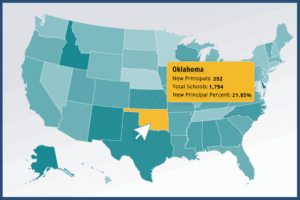
How Many Education Workers Are in the U.S.? Roles, Trends + Market Impact
Discover how many education workers are in the U.S., including key roles and trends—and learn how vendors can engage decision-makers effectively.
What drives real school success? Academic Performance Indicators (APIs) hold the answer. These measurable metrics—used across K–12 and higher ed—offer a snapshot of student achievement and overall school performance. For education vendors, knowing how these indicators work is key to developing tools that align with the goals and challenges schools face every day.
When products are built around the outcomes schools value most, they’re more likely to gain traction and deliver real results. Read on to explore the most common types of APIs, why they matter, and how to offer smarter, more impactful solutions schools need today.
Academic Performance Indicators (APIs) are measurable data points that reflect how students, schools, and institutions are performing. In both K–12 and higher education, they help track progress, shape policies, and guide everyday instruction. These indicators range from test scores and graduation rates to attendance and college readiness benchmarks. And educators and administrators rely on these indicators to identify what’s working, what needs support, and where to focus resources.
While often used alongside outcomes, it helps to distinguish the two:
By centering your tools on the metrics schools actually track, you provide solutions that not only meet institutional goals but also help drive them forward.
APIs aren’t just numbers on a report—they’re critical tools schools and districts use to evaluate what works and what doesn’t. From assessing teaching effectiveness to tracking student progress and program impact, APIs guide education leaders in making informed decisions. These indicators also shape strategic planning, influencing how resources are allocated and directing funding where it counts most.
At the state and federal levels, APIs tie directly to accountability under the Every Student Succeeds Act (ESSA). Schools must report and act on certain performance indicators, such as graduation rates, academic growth, and English language proficiency, to demonstrate progress and maintain funding. These benchmarks drive policy, compliance, and continual improvement.
APIs are usually calculated based on a variety of student data, including test scores, attendance, and graduation rates. Some states combine these into a single overall score. Others use more detailed systems, like state report cards, that weigh each factor differently.
These scoring systems aim to provide a comprehensive picture of how schools are doing and support efforts to improve performance and accountability.
Explore seven core academic performance indicators that offer a comprehensive view of student achievement, school effectiveness, and equity:
Standardized tests are one of the most recognized ways to gauge academic achievement. They measure how well students grasp key subjects and allow comparisons across schools and states. For educators and policymakers, these scores help guide curriculum and accountability efforts. Solution providers can boost impact by aligning their tools with tested skills and standards.
Graduation and dropout rates reflect how well schools support students through to the finish line. High graduation rates point to strong instruction and engagement, while dropout trends often signal deeper issues. These metrics influence funding, rankings, and reputation, making them key targets for tools focused on retention or student support.
You can’t learn if you’re not in the room. Attendance and participation data help schools identify at-risk students early and spot engagement trends. Chronic absenteeism is often linked to lower achievement, so tools that support outreach, virtual learning, or family communication play a vital role in improving this metric.
GPA and course completion offer a fuller picture of student performance over time. They track progress across subjects—not just on test day—and are key for graduation and college readiness. Solutions that support tutoring, pacing, or assignment tracking can help boost GPAs and keep students on track.
Growth metrics show how much progress a student is making, and value-added models can highlight the impact of teachers and programs in different learning environments. Tools that help educators personalize instruction or monitor growth over time directly support this metric.
Student behavior and engagement reveal a lot about their learning environment. Positive engagement often leads to stronger academic results, while spikes in discipline issues may indicate barriers to learning. Solutions that foster social-emotional learning, classroom culture, or behavior tracking can help schools create safer, more supportive spaces.
Are all students getting the same opportunities to succeed? Equity indicators track access to quality teachers, technology, advanced coursework, and safe facilities. As schools focus more on closing gaps, tools that visualize inequities or expand access can drive both impact and adoption.
APIs touch nearly every corner of education, providing value for several stakeholders, including:
Simply put, APIs help connect the dots between data, strategy, and student success.
API data can help you better position your products, show real impact, and build stronger partnerships. Here’s how:
Publicly available API data, such as low proficiency in math or high rates of chronic absenteeism, can reveal where schools are struggling—and where your solution can help. Use this data to tailor product messaging, features, or services to match schools’ most pressing needs. By aligning offerings with the specific outcomes schools aim to improve, you not only boost product relevance but also show that you understand the challenges educators face.
Academic indicators can also guide smart product design. Building tools that track metrics like GPA, attendance, or graduation rates can help schools monitor progress and meet reporting requirements. Plus, features such as dashboards or visual analytics aligned with district and state reporting frameworks can add immediate value. When your solution reflects the metrics schools are already tracking, it becomes a more intuitive and indispensable tool.
Performance trends offer valuable cues for segmentation and messaging. For example, targeting districts with below-average reading scores with literacy-focused solutions makes your outreach more relevant and timely. Similarly, marketing that directly ties your product to improving specific outcomes—like “designed to support attendance goals” or “built to raise ELA scores”—can increase engagement and trust.
Schools aren’t just looking for tools—they’re looking for partners in improvement. By connecting your product to performance goals and accountability plans, you position your brand as a strategic ally. Show how your solution:
Data-driven decision-makers want evidence. Using APIs as benchmarks, you can showcase before-and-after comparisons that highlight gains in key performance categories. Whether through dashboards, third-party evaluations, or customer case studies, showing measurable improvement helps validate your impact and build credibility with new and existing clients.
Academic Performance Indicators are powerful tools for evaluating, comparing, and improving outcomes across the education landscape—and they’re just as valuable for solution providers looking to drive impact. Agile Education Marketing helps turn performance data into actionable insight through unmatched data expertise and comprehensive K–12 data licenses.
From identifying school priorities to segmenting outreach and fine-tuning messaging, Agile empowers vendors to align with what matters most to educators. Smarter data means smarter marketing—and stronger results. Ready to use performance data to drive impact? Explore our K–12 Data Licenses, or reach out to start the conversation today.

Discover how many education workers are in the U.S., including key roles and trends—and learn how vendors can engage decision-makers effectively.

Every new school year brings fresh priorities – and workforce data offers a unique window into how education is changing. Agile’s latest analysis shows a clear shift in how districts and schools are preparing for the future.

Discover effective email marketing strategies for vendors targeting K–12 schools. Learn segmentation, personalization, timing, and best practice tips.
We use cookies to ensure you get the best experience on our website. Learn more.
We’re here ready to answer your questions! Share a little information with us below and one of our Agile experts will be in touch shortly.